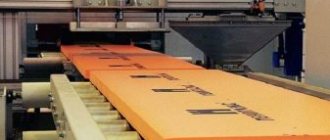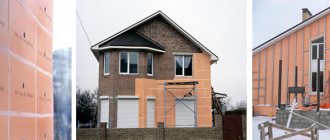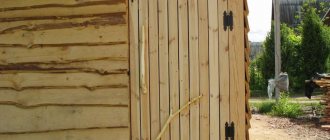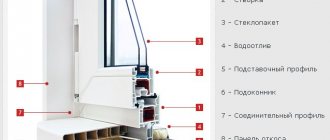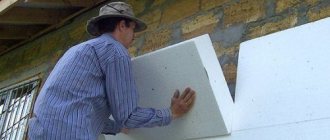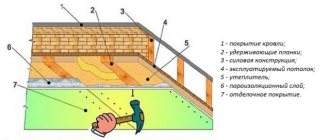Korovin Sergey Dmitrievich
Master of Architecture, graduated from Samara State University of Architecture and Civil Engineering. 11 years of experience in design and construction.
Insulating a home is the primary task of a homeowner who wants to use their home as efficiently as possible. Insulating both a wooden and a stone house from the outside will allow the developer to significantly reduce heating costs, save usable space inside the house and protect the house from the negative effects of atmospheric phenomena and precipitation.
One of the most popular and in demand methods of thermal insulation of housing is the technology of insulating the facade with mineral wool under plaster. You can familiarize yourself with the features, rules, tools and stages of installing mineral wool under plaster below.
What is mineral wool?
Unlike wool for interior work, façade mineral wool is denser and hydrophobic (repels water). Mineral wool for insulating the outside of a wooden, brick and other house is produced exclusively in the form of slabs with dimensions of 0.6x1.2 m and 0.5x1 m. The thickness of the material can be 5, 10, 15 cm. The most popular type is 10-centimeter mineral wool slabs .
Mineral wool is available in three varieties:
At the same time, basalt glass wool, due to its record low thermal conductivity, is considered the best option for insulating the outside of a wooden house.
Pros and cons of using mineral wool for external thermal insulation of a house
The popularity of insulation is primarily due to:
- low thermal conductivity of the material, and therefore high thermal insulation characteristics;
- excellent sound insulation;
- good level of fire safety (after all, mineral wool does not support combustion);
- vapor permeability (provides “breathing” of the house, which is especially important if the house is not wooden, but stone);
- resistance to fungi and rodents;
- relative environmental friendliness and safety of the material (harmful substances are released only when heated to more than 300 ° C);
- simplicity of installation technology.
Thermal insulation of the facade using mineral wool can be done independently.
As disadvantages, it is worth noting:
- change in the volume of insulation and the appearance of cracks in it (occurs only when there is no reinforcing layer);
- If mineral wool is not treated with a hydrophobic solution, all its thermal insulation characteristics will come to naught, because it almost instantly absorbs moisture.
Cost per square meter of work
Installation specialists can offer professional execution of wet finishing of the building facade. Labor costs are calculated as follows:
- Preparing the base of the walls;
- Installation of slabs;
- Application of a reinforcing layer;
- Formation of plaster texture;
- Finishing window slopes;
- Installation and dismantling of scaffolding, etc.
For example, Stroy-Continent has a cost of 1 sq. m of facade insulation starts at 350 rubles, and the group’s price for installing slabs is slightly higher - from 390 rubles per 1 sq. m. m. "LuxElitStroy" for such work puts forward a price of 380 rubles, and the "Brigade of Private Craftsmen" set a price of 300 rubles per square.
Note! It must be taken into account that the cost of facade insulation does not include the remaining stages of work.
High-quality work will provide housing with savings on heating costs, and will also protect it from climate “surprises” for many decades. After all, with proper installation of insulation, the service life of the building increases by 30 years.
Facade surface preparation
Before starting to work with insulation and plaster, it is necessary to clean the surface of the walls from oil stains and dirt and level them. According to technology, all metal elements that may rust must be removed from the walls outside. If these are strategically important metal elements, then it is necessary to ensure the flow of oxygen under the plaster, i.e. this immediately excludes the use of acrylic-based plaster.

The insulation material must have low thermal conductivity. Therefore, mineral wool, namely its variety with a density of 140 kg/m², is ideal.
If there are remnants of the old coating on the walls, be it paint, plaster or anything else, then insulation cannot be placed under the plaster.
Before starting insulation, it is worth using sags to mark the boundaries of the zones. Sags are strong nylon cords pulled between the reinforcement pins (these pins must then be removed, so do not drive them in too tightly), fixed at a designated point in a vertical, horizontal position and diagonally.
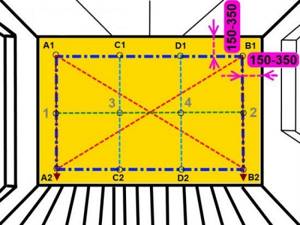
Sags are installed to assess the geometry of the wall
Once the sags are in place, it becomes much easier to evaluate the wall geometry. The sags must be attached so that they retreat at least 1 cm from the mineral wool. After the wall is marked, you can begin installing the guide profiles.
Preparatory work
Before insulating the facade with mineral wool, the walls are cleaned of foreign matter. All surfaces are carefully leveled. Metal elements are removed. This is necessary to prevent rust from forming inside the facade.
Mineral wool should not be laid on remaining plaster or paint.
Recommended material density is 140 kg/m2.
The structure of the casing is shown in the figure below.
How to calculate the required layer thickness is written in detail here.
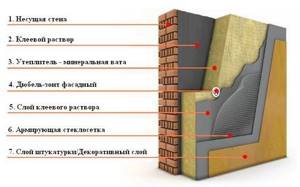
Then the geometry of the wall is necessarily assessed. This is done using sags - nylon cords stretched between reinforcing pins. The pins must be removed in the future, so they are not driven in too much. With the help of such markings, zone boundaries are indicated.
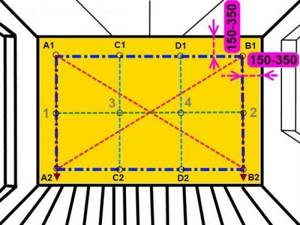
Technology and main stages of insulation
Insulation with mineral wool and subsequent covering with plaster should be carried out in several stages.
There are three such basic stages:
- Installation of thermal insulation.
- Reinforcement.
- Carrying out decorative finishing.
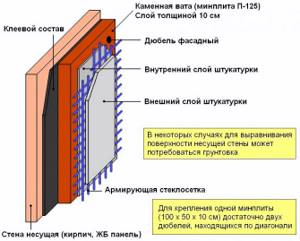
Scheme of insulation cake with installation of mineral wool
First of all, it is worth installing a base profile or strip into the wall, which will serve as a supporting guide for the first row of insulating material; in addition, it will control the gap between the bottom row of mineral wool and the wall, and also protect the mineral wool from the penetration of rodents and pests. It is also important that the profiles protect the plaster layer from mechanical deformation and tightly join the plaster with expansion joints.
The façade is insulated using mineral wool with a density of 140 kg/m². Mineral wool is fixed to the load-bearing walls of the facade using driven dowels or special glue.
After this, a strip of reinforcing mesh (width from 25 to 35 cm) should be attached directly to the mineral wool under the profile. After the reinforcement is glued to the mineral wool, the lower edge of this mesh can be wrapped onto the profile, which completely insulates and makes the insulation monolithic. The reinforcing construction mesh is attached to the mineral wool using adhesive-reinforcing plaster.

Reinforcing mesh prevents mineral wool from destruction
To decorate mineral wool slabs, you can use decorative plaster on a silicate, mineral, acrylic or silicone base. After the plaster has dried, it can be painted with any color that suits the overall color scheme of the façade.
It is extremely important that all materials used in the work are suitable for each other in all respects . For example, thermal insulation and plaster must be compatible with each other regarding the thermal expansion parameter, have the same thermal conductivity coefficient and approximately the same level of hygroscopicity. If you ignore the rules for compatibility of materials, the plaster will crack and crumble extremely quickly, and the insulation will reduce its effectiveness.
To insure against problems with the compatibility of materials, you can purchase a ready-made facade insulation system. The most popular on the market are “Knauf”, “Atlas” and “Ceresit”. Nevertheless, it is worth remembering that even the use of ready-made facade thermal insulation does not exclude the need to follow safety rules and principles of installation of the system. Otherwise, you'll just be throwing money away.
What is mineral wool
This material has a fibrous structure. This determines its high thermal insulation properties. Mineral wool insulation is characterized by good physical and mechanical characteristics. Mineral wool differs from other heat insulators in its immunity to deforming loads . Thanks to this property, this material is very often used in multilayer thermal insulation systems.
- Mineral wool is considered an environmentally friendly material . Therefore, it can even be used in residential buildings.
- This type of insulation has increased fire resistance and can withstand high temperatures well. The material is destroyed at temperatures above 1000 degrees.
- Insulating walls with stone wool from the outside will help achieve good sound insulation characteristics. This insulation has a long service life - 50 - 70 years .
- Mineral wool is resistant to moisture, aggressive chemical environments and large temperature fluctuations.
Mineral wool consists of rocks in a molten state and various binding components (minerals of clay origin and phenol-based resin). And on top of the material, a small layer of kraft paper is applied.
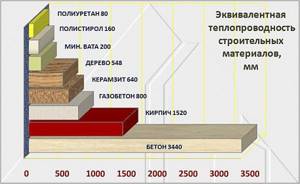
Comparison of mineral wool with other materials
Safety precautions
The algorithm for insulating building walls with mineral wool requires strict adherence to safety standards. Although the material is classified as environmentally friendly, working with it is potentially hazardous to health. The problem lies in the high volatility of the smallest fragments of insulation. If they settle in human lungs, this can become a starting point for the development of serious diseases.

For this reason, it is strongly recommended not to neglect the use of a protective respirator, gloves and goggles to protect the respiratory system, exposed skin and mucous membranes from contact with material fibers.
When the work is completed, you need to do a thorough cleaning - thoroughly rinse the tools that were used during installation, and also clean the surrounding area with a professional vacuum cleaner, or, at worst, a broom soaked in water.
Types of mineral wool
This term means not one material, but five:
- Glass wool. This is the most popular insulating material. When working with such material, you need to wear a special protective suit, goggles and a respirator.
- Slag-like. Numerous disadvantages of this substance do not make it possible to use it as thermal insulation. The material easily absorbs moisture and interacts with metal surfaces, oxidizing them.
- Stone wool. According to its characteristic features, this material resembles slag wool. This type of insulation does not scratch, so it is easier to work with.
- Basalt wool. It does not contain blast furnace slag or various additives. The material is practically not subject to combustion. This variety is most often used as thermal insulation.

Recently, it is often practiced to insulate walls with ecowool. This material is environmentally friendly and has a high degree of sound insulation. It’s up to you to decide which mineral wool is best to use for insulation.
Types of plaster for facades
Mineral wool is an insulation material that is sensitive to the negative effects of external factors. To protect it, additional finishing methods are used, for example, plaster.
There are several varieties of mixtures available for working with mineral wool. When choosing, take into account the plasticity of the material, ease of distribution over the surface, and resistance to mechanical stress. Not least important are water-repellent properties and vapor permeability.
Experts distinguish 4 types of facade plaster. They differ in performance characteristics and composition.
Mineral
Mineral plaster is made on the basis of cement with the addition of components that increase its plasticity, moisture-repellent properties, and degree of adhesion.
Cement mortars are durable, but less plastic. They are difficult to apply and are not recommended for finishing facades, where serious mechanical stress is possible.

Mineral plaster is made on the basis of cement with the addition of components that increase its plasticity
Acrylic
Acrylic mixture is a material based on acrylic resins with the inclusion of mineral components. The solution is plastic, durable, and resistant to temperature changes.
Advantages of the composition:
- moisture resistance;
- high degree of adhesion to the base;
- ease of use;
- high speed of setting and drying.
Acrylic plasters are available in a variety of colors.

Acrylic mixture - a material based on acrylic resins with the inclusion of mineral components
Silicate
Silicate plaster is made from potassium silicate with the addition of acrylic resins. This combination makes the resulting coating strong, durable, and resistant to mechanical stress. Silicate plaster is best suited for finishing mineral wool.
The disadvantages of the material include its demanding installation and short pot life. The solution sets quickly.
Silicate mixtures are supplied to the market ready-made in containers of various sizes.
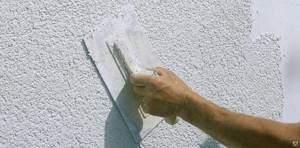
Silicate plaster is made from potassium silicate with the addition of acrylic resins
Silicone
Silicone mortars include the advantages of other types of plasters. They are plastic, vapor permeable, and resistant to fungus. The material has a high degree of adhesion. The finished coating has an antistatic effect and does not attract dirt. Environmentally friendly.
Disadvantages include the high cost of the mixture and the requirement to adhere to operating technology.
It is necessary to apply silicone primer under the plaster.

Silicone solutions are plastic, vapor-permeable, and resistant to fungus
Positive and negative sides of mineral wool
Advantages:
- The material has a high level of fire resistance .
- Good resistance to irritants of chemical and biological origin.
- Mineral wool is free from such a disadvantage as deformation.
- The material is not capable of accumulating liquid. It has low hygroscopicity.
- Vapor permeability indicators are at a high level.
- This insulation has high sound insulation .
- This material is safe for human health.
- Easy to install . Even a builder who does not have much experience can cope with the work of insulating walls with mineral wool.
- Long service life - about seventy years.
Negative sides:
- Glass wool fibers are very brittle and if their structure is disrupted, small fragments can painfully injure a person.
- In some cases, mineral wool contains formaldehyde resin . If it is exposed to high temperature for a long period of time, it will oxidize to phenol (which is poison).
- Thermal insulation made using mineral wool is easily blown out . Therefore, the structure must be carefully covered with decorative finishing material.
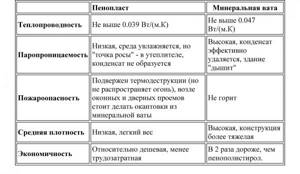
The above disadvantages are not characteristic of stone and basalt wool.
Thickness of mineral wool for wall insulation
The most popular mineral wool product is mineral slabs.
Mineral wool sizes:
- length – 100-600cm
- width – ranges from 20-180cm
- The thickness of mineral wool for wall insulation is usually 10-25 cm.
The interval is quite large, but such indicators were achieved thanks to modern production technology. Mineral wool slabs are easily attached to houses built using frame technology.
Plates with a thickness of 2-25 cm are used for thermal insulation of the facade of a building under plaster . The thickness of mineral wool in mats ranges from 2 to 22 cm (these indicators depend on how the rolls are finished: it can be aluminum foil, fiberglass or wire mesh).
How to insulate a facade with mineral wool under plaster
There are two options for laying mineral wool on facade walls. In the first case, the slabs are attached with glue without fungi, in the second, only fungal dowels are used.

The choice of a specific scheme depends on the material and geometry of the walls of the house. One of the technology options for insulating a facade with mineral wool under plaster is shown in the video
If you are not sure about the quality of installation, then you can use both options for attaching mineral wool to the walls and facade of the building.
Vapor barrier of walls
When carrying out work on wall insulation, you need to do so as to minimize the penetration of moisture from the interior of a residential building under the insulation.
To do this, you need to provide a layer of vapor barrier; it is laid directly on the wall. To do this, you can use an air-permeable diffuse membrane.
The vapor barrier material is attached using a construction stapler; individual strips must be secured with staples. To preserve the insulating properties of the material, it is best to overlap the fabric by 10 -12 cm.
The seams can be additionally insulated with adhesive tape (stationery tape is suitable for this purpose).
How to properly lath under mineral wool on the outside of a wall
The sequence of your actions when insulating walls should be as follows:
- All work surfaces must be thoroughly cleaned and sanitized.
- It is necessary to dismantle various strips, frames, ebbs and other elements.
- Any holes in the wall should be covered with hemp or special mastic.
- The wooden components under the siding are impregnated with a fire-resistant primer, and the walls are coated with an antiseptic.
The sheathing under the mineral wool should be made from wooden blocks (they will later be used to attach the siding). The distance between the beams depends on the width of the slabs being laid.
The sheathing is secured with galvanized nails or dowels. The bars can be placed both horizontally and vertically.
It is necessary to additionally fix the cladding around the perimeter of window and door openings . At the same time, do not forget to check the plane of the frame by level.
The thickness of the wooden beam must correspond to the insulation layer.
Now let's look at step-by-step instructions for insulating the walls of a private house.
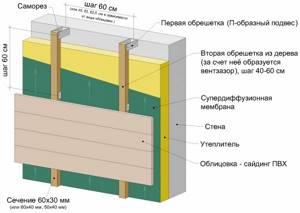
Recommendations and common mistakes
Laying insulation on the facade requires precise adjustment of the slab dimensions. The most common mistake made by beginners is incorrect planning and cutting of the material before laying mineral wool on the walls. Often the space around the window is made up of scraps of insulation. Whereas, according to technology, the perimeter of a window or doorway should be sheathed with solid slabs with cut out corners. In places where window openings are bypassed, the vertical distance from the corner of the window to the horizontal edge must be at least 150 mm.
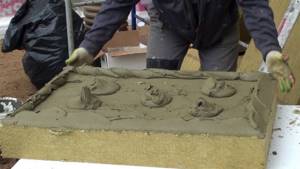
The second mistake is not applying the glue carefully enough. To ensure that the places where mineral wool is glued to the facade are strong, you need to rub the slabs as gently as possible, but at the same time with force, with small amounts of facade glue, then most of the adhesive mass is applied in several “splashes” or along the perimeter of the slab.
Technology of insulating walls outside with mineral wool under siding
Do-it-yourself insulation of the walls of a frame house with mineral wool is carried out according to the following scheme:
- First of all, you need to clean the surface of the walls ; if any unevenness is found on it, they should be puttied.
- In order to increase adhesion, apply a primer to the wall surface.
- Next you need to fill the sheathing . The bars can be stuffed both horizontally and vertically.
- We lay overlapping vapor barrier.
- Your next actions, on which the performance of the entire thermal insulation system will be based, is cutting the insulation. For this work you will need a sharp knife and a wooden board that will serve as a press. The dimensions of the mineral wool slabs must match the dimensions of the sheathing plus 5 mm for installation allowances.
- The next stage is laying insulation between the sheathing bars. It is necessary to ensure a tight fit of the mineral wool slabs at all ends . There should be no gaps between adjacent sheets.
- Arrangement of vertical sheathing . Here you need to take into account the type of siding that will be used to cover the house. For ordinary vinyl siding, you need to make the sheathing with a beam pitch of 400mm. If you plan to install metal siding, then there should be a distance of 600-1000mm between the components of the vertical sheathing.
- If your plans are to make a second layer of thermal insulation, then it should be laid in the same way as the first layer, only perpendicularly.
- Installation of waterproofing.
- Fastening siding panels.
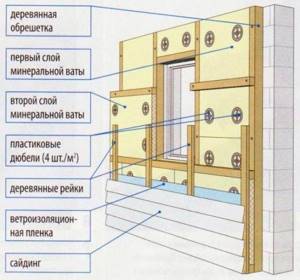
2-layer insulation scheme
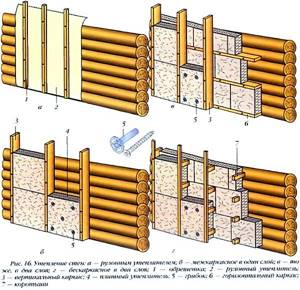
3 methods of laying insulation
What tools and materials will be needed
To install the insulation, you will need a standard cladding kit:
- Impact drill with a set of long drill bits;
- Construction levels hydraulic and regular bubble;
- Notched spatula, rule for plaster;
- A pair of wide brushes for applying primer, a paint roller;
- Scotch tape and stapler, corners for covering the ends of the insulation at the corners of the facade.
- Saw for cutting mineral wool slabs.
The material will have to be cut and adjusted to the place of installation on the surface of the facade. This is a dusty business, so you will need to get a workbench, gloves, goggles and a respirator. On the same table it is convenient to apply glue to the mineral wool slab before laying it.
Materials for insulating the exterior of a façade with a plaster finish will need to be purchased:
- A primer, preferably a deep penetration primer;
- Dry facade adhesive for laying insulation on the facade;
- Facade dowels, with a screw and plug length of at least 200 mm;
- Plastic mesh reinforcing;
- Primer for plastering and decorative plaster itself, preferably silicone.
In addition, you will need a starting galvanized profile, selected for the specific thickness of the mineral fiber board.
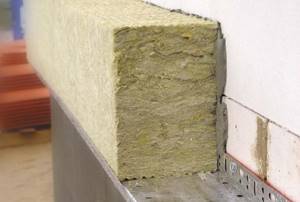
If insulation with mineral wool under plaster is done with your own hands and for the first time, then it is better to purchase consumables with a margin of 5-10%. Defects happen even among experienced craftsmen, so it is better to purchase consumables for insulation and plaster with a reserve than to make insulation from materials pulled from different batches of goods.
Carrying out waterproofing work
Since mineral wool is a thermal insulation material with high water permeability properties, the façade of the house must be provided with good waterproofing.
In order to ensure the process of removing moisture from mineral wool boards, which is formed as a result of temperature differences indoors and outdoors, it is necessary to install a waterproofing film or diffusion membrane.
To ensure water movement only in the outer direction, it is necessary to fasten the waterproofing with the wide side of the pores to the mineral wool, and the narrow side to the sheathing. Self-tapping screws should be used as fastening elements. The waterproofing is laid overlapping, from top to bottom, the seams are taped with mounting tape.
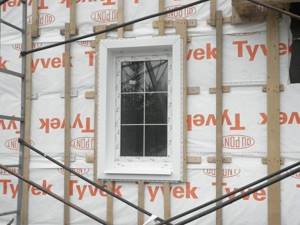
Waterproofing under siding
Available insulation materials for thermal insulation of a brick house
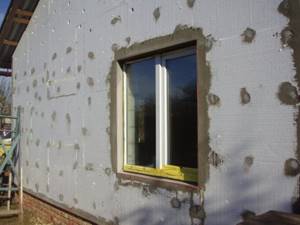
External wall insulation is the most effective.
Home owners, for whom the main factor when choosing a material for insulating a house outside is its cost, decide to insulate with polystyrene foam or expanded polystyrene. Both materials are polymers and have the same chemical composition, but different technologies are used in their production. Therefore, their physical properties differ significantly.
The basis of each material is polystyrene granules, but during the production of polystyrene foam, the granules sinter together and, increasing in volume, form unstable compounds that eventually lose their connection with each other. When insulating a house with polystyrene foam, you must keep in mind that it breaks easily and has high water permeability.
Expanded polystyrene is produced using a completely different technology, which provides the material with a quality that is an order of magnitude higher than that of polystyrene foam. The extrusion method used in its production allows polystyrene granules, when melted, to form a strong structure in which the particles are interconnected at the molecular level, and the closed cells of which it consists are filled with gas.
A comparison between expanded polystyrene and polystyrene foam in terms of physical properties clearly indicates the advantage of the first of the materials. You should know that foam insulation of buildings, even outside, has long been prohibited in many countries.
Both materials are flammable and release toxic substances when burned. However, the ignition temperature of expanded polystyrene is 30% higher compared to polystyrene foam, but the price is on average three times higher. Since even exposure to high air temperatures can destroy foam plastic, thermal insulation made with foam plastic should be protected with a facing layer, which significantly increases the cost of insulating a house. Thermal insulation of a house made with polystyrene foam is 5 times stronger than the construction of polystyrene foam insulation.
Plastering on mineral wool
External placement of insulation requires reliable protection from external influences - precipitation, wind, dust settling, etc. In this regard, mineral wool is a particularly vulnerable material, so the quality of the protective coating is especially important. The plaster must have the appropriate qualities:
- Strength. The insulation must be reliably protected from possible mechanical damage; in addition, violating the integrity of the plaster layer will inevitably cause the mineral wool to become wet and render it inoperable, which is unacceptable.
- Elasticity. A coating capable of some changes in shape without destruction makes it possible to compensate for shrinkage of the building, seasonal soil movements and other destructive influences.
- Vapor permeability. The free release of steam from the wall materials and insulation ensures the functioning of the wall pie in the correct mode, while “locking” moisture inside the walls will cause frost expansion and gradually tear them apart.
- Water-repellent properties. If the coating absorbs moisture, then getting the mineral wool wet is a matter of time. Therefore, a layer of plaster must provide high-quality waterproofing, reliably cutting off the ingress of moisture from the outside.
Selecting a plaster composition that optimally meets such requirements is not an easy task, since there are also specific conditions inherent only to a given building. In addition, the limiting factor is the cost of some compounds, which becomes too high when the area of the house is large. Therefore, there are always at least two choices - ideal, but expensive, and acceptable, but affordable.
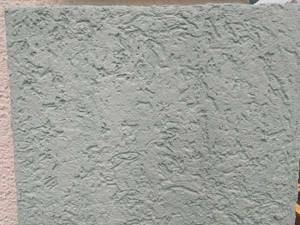
There are several main types of plaster:
- Mineral. Composition - mineral fillers on a cement, lime or mixed basis. There are many varieties, the traditional sand-cement mixture is one of them.
- Silicate. The mixture is based on liquid glass, has high vapor permeability and water-repellent properties, but is not suitable for use on all substrates; intermediate priming with appropriate compounds is required.
- Silicone. This type appeared relatively recently, has high elasticity and water-repellent surface properties. In general, it is an ideal option, but has a high cost, which sharply reduces its popularity.
- Acrylic. The basis of the mixture is acrylic resin, which has sufficient plasticity, high frost resistance and strength. At the same time, the coating burns and also attracts dust and small particles of dirt due to the neutral static charge, which reacts equally to both positively and negatively charged particles.
In terms of the combination of qualities for mineral wool, the best option is silicone plaster, but high prices sometimes force one to abandon this choice in favor of silicate compounds, and some experts consider it an even better choice.
The popularity of thermal insulation with mineral wool
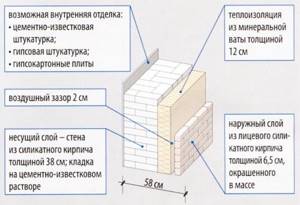
Double-layer wall with mineral wool insulation.
Thermal insulation material such as mineral wool has much better properties. Insulation of buildings from the outside is carried out with mineral wool made from basalt rocks. Compared to the materials described above, polystyrene foam and expanded polystyrene, mineral wool is highly environmentally friendly, as it is made from natural raw materials.
For this reason, insulating the outside of buildings with mineral wool is popular in countries where they pay great attention to the environmental cleanliness of the human environment. However, not only the natural origin contributed to the growth of its popularity. In addition to its excellent ability to retain heat, mineral wool insulation can improve the sound insulation of walls, which is very important for comfort. The fibers, randomly located in the insulation, perfectly muffle sounds.
Since thermal insulation materials from mineral wool are made in various forms, these can be either slabs of varying hardness or rolled materials, it is possible to select the most suitable product for a particular case. The material does not deform during operation, maintaining its dimensions throughout the entire period of operation.
Another important reason for the popularity of mineral wool insulation is that this material can be classified as non-flammable insulation. The basalt fibers from which it is made melt at temperatures above 300°C. Mineral wool is classified as a fire safety material.
Impregnation of mineral wool during its manufacture with special water-repellent compounds gives the material moisture resistance, which is very important when using it when installing a heat-insulating layer.
About the material
There are four types of mineral insulation material:
- glass wool It has a high level of strength and elasticity, a low level of hygroscopicity, and low thermal conductivity. These qualities have made wool the optimal option for insulating the external walls of buildings. During the installation process, it is recommended to comply with safety requirements, since glass fibers are dangerous to the skin and respiratory system;
- basalt. It is based on diabase and gabbro and has a low degree of water absorption. When exposed to fire, it melts without igniting;
- slag. The cheapest option for cotton insulation, which has its drawbacks. It absorbs water and transmits thermal energy. To ensure effective insulation, such material is laid in a thick layer;
- stone. Fire-resistant, vapor-permeable cotton wool that almost does not absorb water. It is distinguished by good strength and the ability to protect against extraneous noise.
An important characteristic of mineral wool is its density. It depends on the production process and is the main factor in the use of a particular material as insulation.
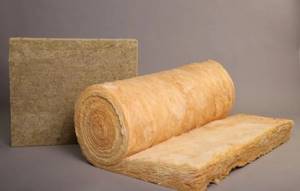
For interior decoration and sound insulation, light mineral wool with a density of 30 to 80 kg is used. per cubic meter. When arranging ventilated external walls, preference is given to insulation, the density of which varies from 80 to 130 kg.
When installing “wet” walls, they use a special series for facade finishing, the density of which is 130 - 160 kg. This insulation is quite durable and can withstand the weight of the plaster layer.
The slabs have dimensions of 50 by 100 or 60 by 120 cm, the thickness ranges from five to fifteen centimeters. Rolled material is also available, but it is difficult to find the appropriate density for finishing facades with it.
Materials and tools necessary for insulating the walls of a brick house
Depending on the chosen method of insulating the house, you may need the following basic tools and materials:
- thermal insulation material;
- metal profile or wooden blocks;
- reinforcing mesh;
- disc dowels and self-tapping screws;
- cladding material;
- electric drill;
- screwdriver
If the final step is plastering the insulating layer, then it is better to purchase a ready-made dry mixture produced for this purpose.
The main methods of thermal insulation of walls using mineral wool
Insulating a brick house with mineral wool from the outside is carried out in several ways. One of them is to fasten insulation boards to the wall of a building using dowels with large diameter caps. Then L-shaped metal profiles are vertically fixed on top of the insulation. With their help, the distance necessary for ventilation between the insulation and the cladding is ensured.
After the installation of the profiles is completed, a facing material is attached to them, which not only protects the insulation from atmospheric influences, but also has a decorative function. For this purpose, special facade panels and siding are used. Facade tiles made from porcelain stoneware look very beautiful. This technology is called “ventilated facade”.
When using ceramic decorative bricks for cladding, profiles are not installed. To securely fasten the cladding layer to the facade, metal pins are inserted into the wall during its construction. With their help, the layer of brick cladding will be firmly connected to the wall of the house. The pins are installed every 3-4 bricks. When laying decorative bricks, be sure to provide a ventilation gap.
A more economical way is to plaster the insulated wall. In this case, before laying the insulation, you should cover the wall with a membrane film, positioning it so that the vapor-permeable side faces the wall of the house. The insulation boards are secured with disc-shaped dowels, then the reinforcing mesh is installed. At the end of all stages of work on insulating the wall, a layer of decorative plaster is applied.
Thanks to the insulation of a brick house with mineral wool, the building will retain heat in the premises much better, which will reduce heating costs and provide comfort for those living in it.



